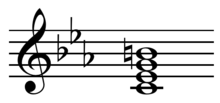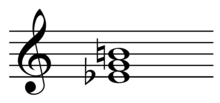- Minor major seventh chord
-
minor/major seventh chord Component intervals from root major seventh perfect fifth minor third root A minor major seventh chord, or minor/major seventh chord
 play (help·info) (written as mM7, mΔ7, -Δ7, mM7, m/M7, m(M7), minmaj7, m⑦, etc.) is a naturally occurring diatonic nondominant seventh chord in the harmonic minor scale. The chord is built on a root, and above that the intervals of a minor third, a major third above that note and above that a major third (see infobox). It can also be viewed as taking a minor triad and adding a major seventh. The traditional numerical notation is based on the degrees of the major diatonic scale, and by this notation a minor major seventh chord is degrees 1, ♭3, 5, 7 of the major scale. For instance, the CmM7 chord consists of the notes C, E♭, G, and B. The chord can be represented by the integer notation {0, 3, 7, 11}.
play (help·info) (written as mM7, mΔ7, -Δ7, mM7, m/M7, m(M7), minmaj7, m⑦, etc.) is a naturally occurring diatonic nondominant seventh chord in the harmonic minor scale. The chord is built on a root, and above that the intervals of a minor third, a major third above that note and above that a major third (see infobox). It can also be viewed as taking a minor triad and adding a major seventh. The traditional numerical notation is based on the degrees of the major diatonic scale, and by this notation a minor major seventh chord is degrees 1, ♭3, 5, 7 of the major scale. For instance, the CmM7 chord consists of the notes C, E♭, G, and B. The chord can be represented by the integer notation {0, 3, 7, 11}.The chord occurs on the tonic when harmonizing the harmonic minor scale in 7th chords. The harmonic minor scale contains a raised seventh, creating a half step between the seventh and the root. This half step creates a pull to the tonic that is useful in harmonic context and is not present in the natural minor scale (also known as the Aeolian mode). When building a chord on the fifth or the seventh of the minor scale, this raised seventh is present, and so both of these chords have a strong pull to the tonic. However, this same effect makes the tonic seventh highly unstable. The raised seventh in conjunction with the tonic creates the dissonant interval of a minor second. Another source of dissonance is the augmented fifth between the third an seventh.
The minor major seventh chord is most often used in jazz, typically functioning as a minor tonic. Jazz musicians usually improvise with the melodic minor scale over this chord; the harmonic minor scale is also used. Additionally, Bernard Herrmann's use of this chord - most notoriously in his score for Psycho - has earned it the nickname, "The Hitchcock Chord".[2] This chord also appears in classical music, but it is used more in the late Romantic period than in the Classical and Baroque periods.
The chord, infrequent in rock and popular music, is, "virtually always found on the fourth scale degree in the major mode," thus making the seventh of the chord the third of the scale and perhaps explaining the rarity of the chord given the, "propensity of the third scale degree to be lowered as a blues alteration."[3] In C: F, A♭, C, E. Examples occur in Lesley Gore's "It's My Party" (see also augmented triad), the Chiffons' "One Fine Day", Mariah Carey's "Vision Of Love", Pink Floyd's Us and Them and the Beatles' "Magical Mystery Tour".[3]
Minor major seventh chord table
Sources
- ^ Benward & Saker (2003). Music: In Theory and Practice, Vol. I, p.230. Seventh Edition. ISBN 978-0-07-294262-0.
- ^ Brown, Royal (1994). Overtones and Undertones: Reading Film Music, chapter 6. ISBN 0520085442. cited in Sullivan, Jack (2006). Hitchcock's Music, p.285. ISBN 0300110502. Cooper, David (2005). Bernard Herrmann's The ghost and Mrs. Muir: a film score guide, p.167. ISBN 0810856794. and Donnelly, Kevin (2005). The Spectre of Sound: Music in Film and Television, p.108. ISBN 1844570258.
- ^ a b Stephenson, Ken (2002). What to Listen for in Rock: A Stylistic Analysis, p.87. ISBN 9780300092394.
Chords By type Major · Minor · Dominant · Dominant seventh flat five · Diminished · Half-diminished · Diminished major · Minor-major · Augmented major · Augmented minor · Nondominant · Harmonic seventh chordAdded
/ omittedBy function SecondaryWith names Elektra chord · Farben chord · Hendrix chord · Mu chord · Mystic chord · Northern lights chord · Petrushka chord · Power chord · Psalms chord · So What chord · Spider chord · Tristan chord · Viennese trichord · Dream chordOther Common chord (music) · Mixed interval · Open chord · Polychord · Primary triad · Quartal and quintal · Slash chord · Subsidiary chord · Synthetic chord · Tone clusterCategories:- Seventh chords
Wikimedia Foundation. 2010.


 in C
in C 
